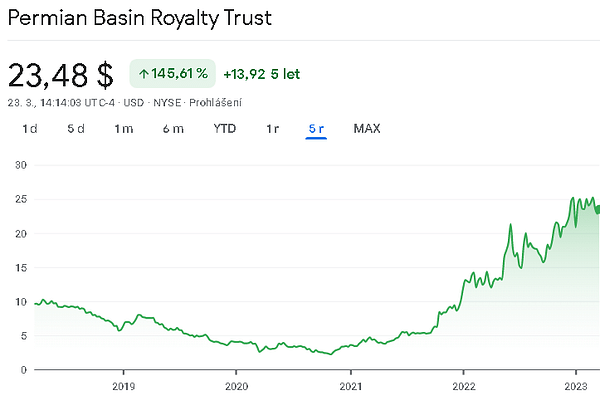This company has an absolutely insane price to book value ratio. Worth considering?
While browsing through the various companies that do business in the US, I came across one company that immediately caught my eye. What caught my eye wasn't the dividend yield, or any other metrics that investors are normally interested in. It was the price to book value ratio, which is absolutely insane here.

Today we're going to look at a company that currently has an absolutely unreal price-to-book value ratio. In fact, that ratio is currently at 2298. But before you get scared, and run away, let's briefly introduce the company, and also explain why this company has this absolutely insane price to book value ratio, because it's due to the nature of the company's business.
Permian Basin Royalty Trust $PBT

Permian Basin Royalty Trust is a publicly traded royalty trust that was formed to own and collect royalties from oil and gas properties located in the Permian Basin of West Texas and Southeastern New Mexico.
The Permian Basin Royalty Trust was formed in 1980 by Mesa Petroleum Company (now part of ConocoPhillips) to own and manage senior royalty interests in oil and gas properties in the Permian Basin. The Trust's initial public offering was completed in 1986 and has since traded on the New York Stock Exchange under the symbol $PBT. The Trust's assets consist of royalty interests in properties operated by ConocoPhillips and other operators in the Permian Basin.
The primary source of income for the Permian Basin Royalty Trust is the production of oil and natural gas from the properties in which it holds royalty interests. The Trust receives a percentage of the revenues generated by oil and gas production and these revenues are distributed monthly to the unitholders. In addition to production revenue, the Trust also receives proceeds from the sale of properties, including the sale of royalty interests.
The company's income is quite dependent on fluctuations in oil and gas prices in the markets, so it is reasonable to assume that the company has done quite well in the past. The company reported revenues of USD 54.47 billion last year, an increase of 361% year-on-year. However, such results cannot be counted on in the future as they are dependent on commodity prices. For 2022, the company generated a net profit of USD 53.54 billion, which in turn represents a rapid year-on-year increase of 399%.
On the balance sheet, we can find the reason why the company has such a high price-to-book value ratio. This is because the company owns virtually no assets, or rather the company's entire assets are royalties and cash on hand. The company simply collects royalties from its share of production. It therefore owns no tangible assets. The big advantage here is also that the company has no debt at all. Since the company needs virtually nothing to run its business, it has no reason to go into debt and borrow money.
Now, you may be thinking that somehow this looks too good. A company that practically only makes money by collecting royalties from miners has no debt, of course there are always risks, so let's look at the pros and cons of this investment.
Advantages:
- High Dividend Yield: As a royalty trust, the Permian Basin Royalty Trust is designed to pay out most of its profits to shareholders in the form of dividends. Currently, the company offers a high dividend yield, which may be attractive to investors seeking income.
- Exposure to the Energy Sector: Permian Basin Royalty Trust's primary focus is on oil and gas production in the Permian Basin, one of the world's largest oil and gas producing areas. As a result, the company can provide exposure to the energy sector and the potential for capital appreciation as oil prices rise.
- Passive Investment: As a royalty trust, the Permian Basin Royalty Trust is a passive investment that does not require active management or ongoing capital expenditures. This may be attractive to investors who prefer a more hands-off approach to investing.
Disadvantages:
- Dependence on oil and gas prices: The primary source of income for Permian Basin Royalty Trust is oil and gas sales. As a result, the company's financial performance is highly dependent on prevailing market prices for these commodities. If oil and gas prices decline, the Company's earnings and dividend payments could be adversely affected.
- Limited diversification: Permian Basin Royalty Trust is a relatively small company focused on one geographic region and industry. This lack of diversification could increase the company's exposure to industry-specific risks and reduce its long-term growth potential.
- Limited control over operations: As a passive investment, Permian Basin Royalty Trust has limited control over the oil and gas operations that generate its revenue. This lack of control could limit the company's ability to respond to market changes or optimize production efficiency.
What also needs to be considered is that Permian Basin Royalty Trust is a pass-through entity for tax purposes, which means that its income is not taxed at the corporate level. Instead, its income is passed through to the shareholders, who are responsible for paying taxes on their pro rata share of the trust's income.
It is very difficult to estimate a fair price here in such a hasty manner. Indeed, as is obvious on the face of it, we cannot start from a balance sheet. So it means that everyone has to estimate the fair share price for themselves according to their expectations in the energy sector.
We have recently launched a new project, Bulios Dividends, whereby we manage a sample portfolio of dividend stocks. These two stocks are not in our portfolio. If you would like to see which stocks we have selected for our portfolio that generate a stable dividend income of more than 7%, feel free to take a look here.
WARNING: I am not a financial advisor, and this material does not serve as a financial or investment recommendation. The content of this material is purely informational.